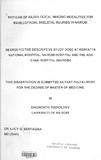Pattern of radiological imaging modalities for maxillofacial skeletal injuries in Nairobi
Abstract
INTRODUCTION:A review of 200 patients who presented in three
major hospitals in Nairobi for maxillofacial skeletal trauma (MFST)
imaging in a five- year period from Jan. 1998to Dec. 2000.
OBJECTIVES:To show the pattern of radiological imaging utilization
in the diagnosis of MFST in Nairobi, and to determine the number of
plain films and particular projections required for the diagnosis of
MFST in the different hospitals.
DESIGN:A retrospective descriptive study.
SETTING:Kenyatta National Hospital, Aga Khan Hospital and
Nairobi Hospital.
SUBJECTS:200 cases of MFST seen in these hospitals.
METHODS:Review of patients' files and radiological reports.
MAIN OUTCOME MEASURE:Variation in utilization of imaging
modalities in the three hospitals.
RESULTS:There were 168 males and 30 females investigated (for 2
patients the gender was not indicated). The age group that was most
commonly affected was 31 to 35 years. The most frequent indication
for imaging was a suspected facial fracture (97%). Plain radiography
was the most frequent examination performed in the primary
investigation (71%). Under- utilization of CT scan as an imaging
modality was demonstrated, where it was not performed in 69.3% of
the cases. There was a wide variation in the use of radiographic
views of the face among the hospitals with a p-value of 0.01 (the
statistical measure of effect was the chi-squared test). In many of
the cases an average of one to two films were used (43.5%)with an
extreme finding of four patients for whom more than eight films were
used. The predominant cause of injury was assault (48.7%), with
mandibular fractures appearing commonest among all the facial
fractures investigated (33.7%).
CONCLUSION:The variation observed among the hospitals with regard to the
imaging of facial skeletal injuries require further investigation
in order to determine what the basic standard radiographic
images may be necessary for the average case of MFST.
Citation
Master Of Medicine In Diagnostic Radiology University Of Nairobi, 2002Publisher
University of Nairobi. Faculty of Medicine

